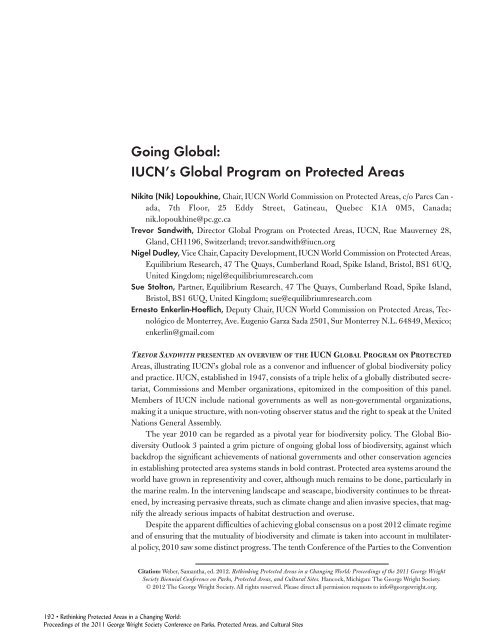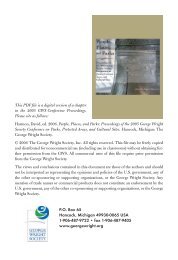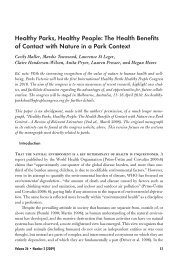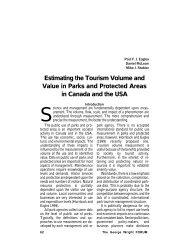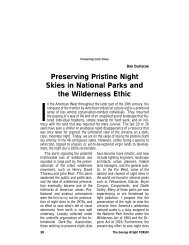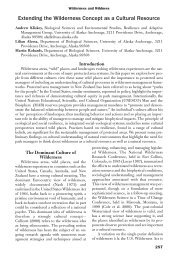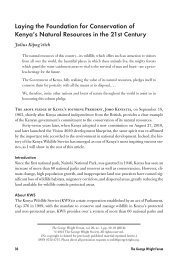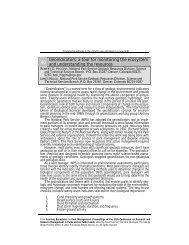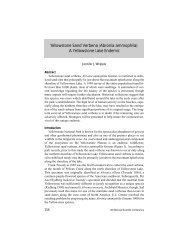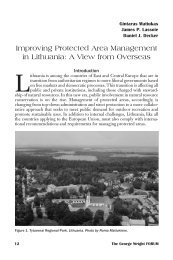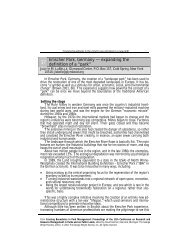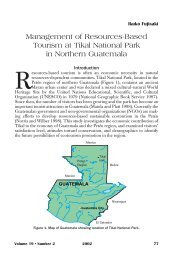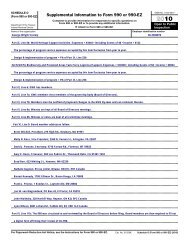Going Global: IUCN's Global Program on Protected Areas
Going Global: IUCN's Global Program on Protected Areas
Going Global: IUCN's Global Program on Protected Areas
You also want an ePaper? Increase the reach of your titles
YUMPU automatically turns print PDFs into web optimized ePapers that Google loves.
<str<strong>on</strong>g>Going</str<strong>on</strong>g> <str<strong>on</strong>g>Global</str<strong>on</strong>g>:<br />
IUCN’s <str<strong>on</strong>g>Global</str<strong>on</strong>g> <str<strong>on</strong>g>Program</str<strong>on</strong>g> <strong>on</strong> <strong>Protected</strong> <strong>Areas</strong><br />
Nikita (Nik) Lopoukhine, Chair, IUCN World Commissi<strong>on</strong> <strong>on</strong> <strong>Protected</strong> <strong>Areas</strong>, c/o Parcs Can -<br />
ada, 7th Floor, 25 Eddy Street, Gatineau, Quebec K1A 0M5, Canada;<br />
nik.lopoukhine@pc.gc.ca<br />
Trevor Sandwith, Director <str<strong>on</strong>g>Global</str<strong>on</strong>g> <str<strong>on</strong>g>Program</str<strong>on</strong>g> <strong>on</strong> <strong>Protected</strong> <strong>Areas</strong>, IUCN, Rue Mauverney 28,<br />
Gland, CH1196, Switzerland; trevor.sandwith@iucn.org<br />
Nigel Dudley, Vice Chair, Capacity Development, IUCN World Commissi<strong>on</strong> <strong>on</strong> <strong>Protected</strong> <strong>Areas</strong>,<br />
Equilibrium Research, 47 The Quays, Cumberland Road, Spike Island, Bristol, BS1 6UQ,<br />
United Kingdom; nigel@equilibriumresearch.com<br />
Sue Stolt<strong>on</strong>, Partner, Equilibrium Research, 47 The Quays, Cumberland Road, Spike Island,<br />
Bristol, BS1 6UQ, United Kingdom; sue@equilibriumresearch.com<br />
Ernesto Enkerlin-Hoeflich, Deputy Chair, IUCN World Commissi<strong>on</strong> <strong>on</strong> <strong>Protected</strong> <strong>Areas</strong>, Tec -<br />
nológico de M<strong>on</strong>terrey, Ave. Eugenio Garza Sada 2501, Sur M<strong>on</strong>terrey N.L. 64849, Mexico;<br />
enkerlin@gmail.com<br />
TREVOR SANDWITH PRESENTED AN OVERVIEW OF THE IUCN GLOBAL PROGRAM ON PROTECTED<br />
<strong>Areas</strong>, illustrating IUCN’s global role as a c<strong>on</strong>venor and influencer of global biodiversity policy<br />
and practice. IUCN, established in 1947, c<strong>on</strong>sists of a triple helix of a globally distributed secretariat,<br />
Commissi<strong>on</strong>s and Member organizati<strong>on</strong>s, epitomized in the compositi<strong>on</strong> of this panel.<br />
Members of IUCN include nati<strong>on</strong>al governments as well as n<strong>on</strong>-governmental organizati<strong>on</strong>s,<br />
making it a unique structure, with n<strong>on</strong>-voting observer status and the right to speak at the United<br />
Nati<strong>on</strong>s General Assembly.<br />
The year 2010 can be regarded as a pivotal year for biodiversity policy. The <str<strong>on</strong>g>Global</str<strong>on</strong>g> Bio -<br />
diversity Outlook 3 painted a grim picture of <strong>on</strong>going global loss of biodiversity, against which<br />
backdrop the significant achievements of nati<strong>on</strong>al governments and other c<strong>on</strong>servati<strong>on</strong> agencies<br />
in establishing protected area systems stands in bold c<strong>on</strong>trast. <strong>Protected</strong> area systems around the<br />
world have grown in representivity and cover, although much remains to be d<strong>on</strong>e, particularly in<br />
the marine realm. In the intervening landscape and seascape, biodiversity c<strong>on</strong>tinues to be threatened,<br />
by increasing pervasive threats, such as climate change and alien invasive species, that magnify<br />
the already serious impacts of habitat destructi<strong>on</strong> and overuse.<br />
Despite the apparent difficulties of achieving global c<strong>on</strong>sensus <strong>on</strong> a post 2012 climate regime<br />
and of ensuring that the mutuality of biodiversity and climate is taken into account in multilateral<br />
policy, 2010 saw some distinct progress. The tenth C<strong>on</strong>ference of the Parties to the C<strong>on</strong>venti<strong>on</strong><br />
Citati<strong>on</strong>: Weber, Samantha, ed. 2012. Rethinking <strong>Protected</strong> <strong>Areas</strong> in a Changing World: Pro ceedings of the 2011 George Wright<br />
Society Biennial C<strong>on</strong>ference <strong>on</strong> Parks, Pro tected <strong>Areas</strong>, and Cul tural Sites. Hancock, Michigan: The George Wright Society.<br />
© 2012 The George Wright Society. All rights reserved. Please direct all permissi<strong>on</strong> requests to info@georgewright.org.<br />
192 • Rethinking <strong>Protected</strong> <strong>Areas</strong> in a Changing World:<br />
Proceedings of the 2011 George Wright Society C<strong>on</strong>ference <strong>on</strong> Parks, <strong>Protected</strong> <strong>Areas</strong>, and Cultural Sites
<strong>on</strong> Biological Diversity (CBD) adopted a new strategic plan for biodiversity 2011-2020 that<br />
includes 20 important targets, including making linkages between biodiversity, ecosystem services<br />
and climate change. In the negotiati<strong>on</strong>s <strong>on</strong> climate change policy, there was the recogniti<strong>on</strong> that<br />
ecosystem-based approaches to climate change mitigati<strong>on</strong> and adaptati<strong>on</strong> were an essential part<br />
of the soluti<strong>on</strong>.<br />
Against this background, an IUCN-commissi<strong>on</strong>ed Strategic Review of the IUCN <str<strong>on</strong>g>Program</str<strong>on</strong>g><br />
<strong>on</strong> <strong>Protected</strong> <strong>Areas</strong> was c<strong>on</strong>cluded in 2010, making far-reaching recommendati<strong>on</strong>s for the<br />
revised objectives and functi<strong>on</strong>s of a new <str<strong>on</strong>g>Global</str<strong>on</strong>g> <str<strong>on</strong>g>Program</str<strong>on</strong>g> <strong>on</strong> <strong>Protected</strong> <strong>Areas</strong> (GPAP). These<br />
included the reinstatement of the positi<strong>on</strong> of a Director and the strengthening of the GPAP<br />
through prioritized budget support. It also sought a renewed relati<strong>on</strong>ship with the IUCN World<br />
Commissi<strong>on</strong> <strong>on</strong> <strong>Protected</strong> <strong>Areas</strong> (WCPA) and the World <strong>Protected</strong> <strong>Areas</strong> Leadership Forum.<br />
Am<strong>on</strong>g other imperatives described in the recommendati<strong>on</strong>s, the GPAP’s renewed focus<br />
should include the following:<br />
• Coordinate the activities involving protected areas across IUCN’s global thematic and<br />
regi<strong>on</strong>al programs, leading to funding and implementati<strong>on</strong> of joint initiatives and projects.<br />
• Lead to increased support and synergy with the IUCN WCPA and the World <strong>Protected</strong><br />
<strong>Areas</strong> Leadership Forum.<br />
• Support the strengthened implementati<strong>on</strong> of the CBD’s <str<strong>on</strong>g>Program</str<strong>on</strong>g> of Work <strong>on</strong> <strong>Protected</strong><br />
<strong>Areas</strong> (PoWPA) through a strategic relati<strong>on</strong>ship with the CBD Secretariat and partner<br />
organizati<strong>on</strong>s.<br />
• Integrate scientific discipline into the development of enhanced knowledge and instituti<strong>on</strong>al<br />
capacity to effectively manage systems of protected areas in all biomes.<br />
• Mainstream protected areas into processes that maintain the integrity of ecosystems in the<br />
face of global challenges such as climate change and that underpin sustainable development.<br />
• Advocate and communicate the essential role of protected areas through an enhanced<br />
communicati<strong>on</strong> program and through a strategic program for influencing global and<br />
nati<strong>on</strong>al policy.<br />
• Lead to a visible impact at the IUCN World C<strong>on</strong>servati<strong>on</strong> C<strong>on</strong>gress in 2012 and the sixth<br />
IUCN World Parks C<strong>on</strong>gress in 2014.<br />
The following are the currently identified priorities:<br />
1. Enhance the capacity to effectively manage protected areas.<br />
2. Mainstream protected areas as natural soluti<strong>on</strong>s to climate change.<br />
3. Foster equitable governance of protected area systems.<br />
4. Make the case for sustainable financing of protected area systems.<br />
5. Communicate and advocate the value of protected area systems.<br />
Highlighted activities<br />
<strong>Protected</strong> areas are established to achieve the “l<strong>on</strong>g-term c<strong>on</strong>servati<strong>on</strong> of nature with associated<br />
ecosystem services and cultural values”. This requires the measurement of these outcomes, and<br />
the development of the means to achieve these outcomes. The CBD Strategic Plan sets a framework<br />
for nati<strong>on</strong>al governments to set and achieve nati<strong>on</strong>al targets, and IUCN and IUCN WCPA<br />
are requested to provide technical support, including the applicati<strong>on</strong> of management effectiveness<br />
assessments and the development of guidance across a broad range of activities in support<br />
of these goals. The Strategic Review of the GPAP emphasizes the need for enhanced scientific<br />
underpinning of management effectiveness and for developing appropriate capacity development<br />
Rethinking <strong>Protected</strong> <strong>Areas</strong> in a Changing World: • 193<br />
Proceedings of the 2011 George Wright Society C<strong>on</strong>ference <strong>on</strong> Parks, <strong>Protected</strong> <strong>Areas</strong>, and Cultural Sites
at nati<strong>on</strong>al levels. C<strong>on</strong>temporary approaches to capacity development stress the importance of<br />
instituti<strong>on</strong>al and individual competence as outcomes of learning situated in practice. In additi<strong>on</strong>,<br />
IUCN as a founder and promoter of a large comp<strong>on</strong>ent of this body of protected area policy must<br />
m<strong>on</strong>itor and learn from the implementati<strong>on</strong> of policy in practice and advocate enhancements at<br />
all levels. IUCN and WCPA have a rich heritage of involvement in guiding and enhancing best<br />
practices for the establishment and management of protected area systems, and many of IUCN’s<br />
member organisati<strong>on</strong>s are the nati<strong>on</strong>al parks and protected area management agencies of the<br />
world, including some of the largest and smallest agencies. The ability to develop and share less<strong>on</strong>s<br />
across these agencies is <strong>on</strong>e of the key added values of the Uni<strong>on</strong>, epitomised in many ways<br />
by the decadal World Parks C<strong>on</strong>gress, where peer to peer leadership across the globe is prominent,<br />
and independent of the limitati<strong>on</strong>s of political or multilateral processes.<br />
Based <strong>on</strong> the c<strong>on</strong>victi<strong>on</strong> that resilient natural ecosystems are indispensable for sequestering<br />
and storing organic carb<strong>on</strong> for mitigati<strong>on</strong>, and for maintaining the ecosystem services that are<br />
essential for societal adaptati<strong>on</strong> to climate change, the c<strong>on</strong>servati<strong>on</strong> community has adopted wide<br />
ranging decisi<strong>on</strong>s in both the CBD and United Nati<strong>on</strong>s Framework C<strong>on</strong>venti<strong>on</strong> <strong>on</strong> Climate<br />
Change (UNFCCC) negotiati<strong>on</strong>s that recognize and employ ecosystem-based approaches. This<br />
has been the policy positi<strong>on</strong> of IUCN’s thematic program <strong>on</strong> climate change that advocates<br />
nature-based soluti<strong>on</strong>s.<br />
The existing, and increasingly important role of protected area systems in c<strong>on</strong>tributing to the<br />
cost-effective c<strong>on</strong>servati<strong>on</strong> of intact, c<strong>on</strong>nected, and therefore resilient ecosystems, has been supported<br />
by scientific and socio-ec<strong>on</strong>omic analysis, including the Millennium Ecosystem Assess -<br />
ment and the recently released The Ec<strong>on</strong>omics of Ecosystems and Biodiversity (TEEB) report.<br />
It has res<strong>on</strong>ated with the parties to the CBD which has included direct references to ecosystembased<br />
approaches to climate change adaptati<strong>on</strong> and mitigati<strong>on</strong> in the targets and goals of the<br />
Strategic Plan for Biodiversity 2011–2020, in the PoWPA, and in many associated programs of<br />
work (Inland Waters, Forests, Agriculture, Marine and Coastal).<br />
It has also been recognised in the deliberati<strong>on</strong>s of the UNFCCC negotiati<strong>on</strong>s <strong>on</strong> l<strong>on</strong>g-term<br />
Cooperative Acti<strong>on</strong> for mitigati<strong>on</strong> and for adaptati<strong>on</strong>, where there has been agreement <strong>on</strong> the<br />
causal link between ecosystem resilience and societal resilience to climate change, and the need<br />
to develop ecosystem-based approaches.<br />
Opportunities for resp<strong>on</strong>ding to these developments include the following:<br />
• Developing guidance <strong>on</strong> how to address the impact of climate change <strong>on</strong> protected area<br />
systems and their objectives, at the site and system level<br />
• Promoting the c<strong>on</strong>tributi<strong>on</strong> of protected areas within ecosystem-based approaches to climate<br />
change mitigati<strong>on</strong> at nati<strong>on</strong>al and sub-nati<strong>on</strong>al levels, including the co-benefits for<br />
biodiversity of REDD+ schemes, and carb<strong>on</strong> storage in biomes other than forests<br />
• Promoting the c<strong>on</strong>tributi<strong>on</strong> of protected areas within ecosystem-based approaches to<br />
adaptati<strong>on</strong> at nati<strong>on</strong>al and sub-nati<strong>on</strong>al levels, including for maintenance of water and<br />
food security, disaster risk reducti<strong>on</strong>, human health and alternative livelihoods<br />
• Ensuring the participati<strong>on</strong> of communities of all types, including indigenous peoples,<br />
local communities, the private sector and co-management structures, in the management<br />
and governance of protected area systems across the landscape and seascape<br />
• Reducing the impact of climate change resp<strong>on</strong>se measures <strong>on</strong> protected areas and the<br />
ecosystems they protect<br />
• Promoting the use of protected areas in ecosystem-based approaches to address effects <strong>on</strong><br />
biodiversity-based livelihoods<br />
• Accessing funding for maintaining protected areas in the face of climate change and for<br />
both mitigati<strong>on</strong> and adaptati<strong>on</strong> purposes<br />
194 • Rethinking <strong>Protected</strong> <strong>Areas</strong> in a Changing World:<br />
Proceedings of the 2011 George Wright Society C<strong>on</strong>ference <strong>on</strong> Parks, <strong>Protected</strong> <strong>Areas</strong>, and Cultural Sites
Sue Stolt<strong>on</strong> and Nigel Dudley outlined the way in which the IUCN WCPA was resp<strong>on</strong>ding to this<br />
opportunity. In terms of social and governance issues (element 2 of the PoWPA), the IUCN<br />
WCPA is moving forward though these efforts:<br />
• Working with experts to develop a methodology and best practices <strong>on</strong> social assessment<br />
of protected areas<br />
• Interacting with key stakeholder <strong>on</strong> the relati<strong>on</strong>ship with Sacred Natural Sites and protected<br />
area commitments<br />
• Producing guidelines <strong>on</strong> applicati<strong>on</strong> of protected area categories in: Indigenous and<br />
Community C<strong>on</strong>served <strong>Areas</strong>; and private sector reserves<br />
Understanding the values, costs and benefits of protected areas is becoming an increasingly<br />
important focus for all those working in protected area. The IUCN WCPA is planning to c<strong>on</strong>tribute<br />
to the understanding of these issues in this way:<br />
• Providing guidance <strong>on</strong> identifying and managing protected area networks to provide the<br />
widest range of possible benefits without compromising biodiversity c<strong>on</strong>servati<strong>on</strong><br />
• Identifying cross-sectoral partnerships to work <strong>on</strong> protected area and ecosystem service<br />
strategies<br />
<strong>Protected</strong> areas and climate change have become a priority issue <strong>on</strong> many levels in recent years.<br />
The IUCN WCPA is c<strong>on</strong>tributing to the understanding of the relati<strong>on</strong>ship between protected<br />
areas and climate change through these efforts:<br />
• Publishing guidelines and case studies <strong>on</strong> managing protected areas under climate change<br />
• Developing and implementing tools to identify benefits from protected areas to help mitigate<br />
and adapt to climate change<br />
• Developing guidance for governments in incorporating protected areas into nati<strong>on</strong>al climate<br />
change strategies and acti<strong>on</strong> plans<br />
• Promoting the Natural Soluti<strong>on</strong>s: <strong>Protected</strong> areas helping people cope with climate<br />
change report which IUCN WCPA collaborated with The Nature C<strong>on</strong>servancy, United<br />
Nati<strong>on</strong>s Development <str<strong>on</strong>g>Program</str<strong>on</strong>g>, Wildlife C<strong>on</strong>servati<strong>on</strong> Society, The World Bank and<br />
WWF to produce in 2010<br />
Given the many pressures <strong>on</strong> protected areas, such as the impacts of climate change, issues related<br />
to c<strong>on</strong>nectivity and corridors have been identified as <strong>on</strong>e of the newly important areas for the<br />
PoWPA. The IUCN WCPA is taking a lead in several parts of the world to facilitate the following:<br />
• The establishment and management of large scale c<strong>on</strong>nectivity c<strong>on</strong>servati<strong>on</strong> areas<br />
• Voluntary structures and systems for the internati<strong>on</strong>al management and recording of c<strong>on</strong>nectivity<br />
c<strong>on</strong>servati<strong>on</strong> areas, such as the Alps the Athert<strong>on</strong> Corridor in Australia<br />
The IUCN WCPA is planning the following to build capacity for protected areas:<br />
• A global standard syllabus and training materials for protected area managers, protected<br />
area system managers and rangers<br />
• An accreditati<strong>on</strong> system for academic instituti<strong>on</strong>s providing protected area training<br />
• A global scholarship fund for protected area professi<strong>on</strong>als<br />
Rethinking <strong>Protected</strong> <strong>Areas</strong> in a Changing World: • 195<br />
Proceedings of the 2011 George Wright Society C<strong>on</strong>ference <strong>on</strong> Parks, <strong>Protected</strong> <strong>Areas</strong>, and Cultural Sites
The IUCN WCPA has led the development of a management effectiveness framework, and<br />
nati<strong>on</strong>al and site implementati<strong>on</strong>. This work will c<strong>on</strong>tinue in these ways:<br />
• Supporting worldwide assessments of protected area management effectiveness (to help<br />
countries reach the PoWPA target of 60% of areas assessed)<br />
• Developing, testing, and refining management effectiveness assessment systems to include<br />
more social and climate change impact indicators<br />
Marine areas are still dramatically under-protected worldwide. The IUCN WCPA will thus c<strong>on</strong>tinue<br />
a major effort to secure a well planned and effectively managed marine protected area (MPA)<br />
network. Specific acti<strong>on</strong>s include the development of the following:<br />
Additi<strong>on</strong>al guidance for implementing the IUCN categories in MPAs<br />
Methodology development and implementati<strong>on</strong> of management effectiveness assessments in<br />
MPAs<br />
In many part of the world protected areas require restorati<strong>on</strong> of habitats, al<strong>on</strong>g with effective<br />
management. The IUCN WCPA is developing a new effort <strong>on</strong> restorati<strong>on</strong> which includes the<br />
following:<br />
• Publishing best practice protected area guidelines for ecological restorati<strong>on</strong><br />
• C<strong>on</strong>ducting further awareness raising, capacity building, m<strong>on</strong>itoring, research, and support<br />
of implementati<strong>on</strong> of restorati<strong>on</strong> activities<br />
Finally, but clearly very importantly, the IUCN WCPA has a new task force working with the<br />
IUCN Species Survival Commissi<strong>on</strong> looking at biodiversity and protected areas. This task force<br />
has two key areas of work:<br />
• C<strong>on</strong>ducting a meta-analysis of relevant studies, and establishing a system to manage data<br />
<strong>on</strong> trends in species of c<strong>on</strong>servati<strong>on</strong> c<strong>on</strong>cern in and out of protected areas<br />
• Facilitating a process to develop a comm<strong>on</strong> global standard for the identificati<strong>on</strong> and validati<strong>on</strong><br />
of such key biodiversity areas<br />
The panel c<strong>on</strong>cluded with reacti<strong>on</strong>s from Ernesto Enkerlin-Hoeflich, Alan Latourelle and<br />
J<strong>on</strong> Jarvis, who reinforced and enhanced the underlying needs and approaches, with examples<br />
from Mexico, Canada, and the USA. In particular, they argued for the incorporati<strong>on</strong> of a variety<br />
of approaches, as opposed to the setting of global standards, and for much greater communicati<strong>on</strong><br />
with the public and thought-leaders <strong>on</strong> the issues of c<strong>on</strong>servati<strong>on</strong>, and the intersecti<strong>on</strong> with<br />
sectoral development needs and directi<strong>on</strong>s. Enhancing public awareness is a preoccupati<strong>on</strong> for<br />
the heads of parks agencies around the world. Increasing urbanizati<strong>on</strong>, immigrati<strong>on</strong>, and aging<br />
populati<strong>on</strong>s in the developed world present particular challenges for making protected areas relevant.<br />
196 • Rethinking <strong>Protected</strong> <strong>Areas</strong> in a Changing World:<br />
Proceedings of the 2011 George Wright Society C<strong>on</strong>ference <strong>on</strong> Parks, <strong>Protected</strong> <strong>Areas</strong>, and Cultural Sites


